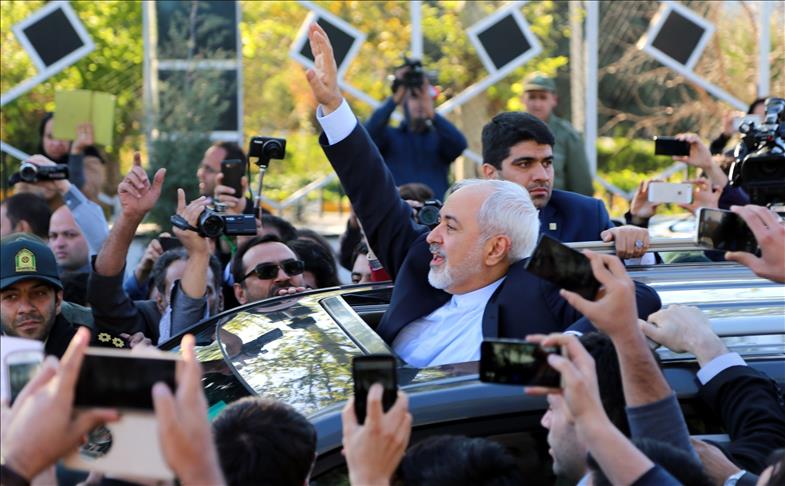Timeline of Iran's nuclear program
AA marks the 58-year journey of Iran's nuclear program from the time it first came to the fore in world agenda to Thursday's deal that promises to ensure Tehran’s nuclear development remains solely peaceful

ANKARA
Over the past 18 months, world powers and Iran conducted negotiations over Iran’s controversial nuclear program and Thursday night they reached a deal that is expected to translate into a final agreement in the coming months.
Iranian President Hassan Rouhani confirmed Thursday that a compromise on a framework accord over Iran’s controversial nuclear program was achieved with the world powers group of the US, Russia, Britain, France, China and Germany -- known as the P5+1 -- after a marathon session of talks in Lausanne, Switzerland.
In the coming weeks Iran and world powers will write the text of a joint comprehensive plan, including technical details, and have committed to complete it by June 30.
Below is a chronology of milestones in Iran’s nuclear program, which overwhelmingly occupied Iran’s international agenda over the last decade.
1957: Iranian Shah, Mohammad Reza Pahlavi, signs a nuclear cooperation agreement with the United States, part of the U.S. Atoms for Peace program.
1967: Tehran Research Reactor -- first of its kind in Iran -- begins operating.
1968: Iran signs the Nuclear Non-Proliferation Treaty.
1973: The U.S., France, Namibia, South Africa and West Germany sign agreements on nuclear matters.
1974: A West German company begins the construction of the first nuclear plant near Iran’s southeastern city of Bushehr. Shah Pahlavi says Iran would have its own nuclear weapon, but steps back in later conversations.
1979: After the Islamic Revolution, the new Iranian administration cancels agreement on building a new power plant. An agreement signed with the U.S. a year earlier on providing enriched uranium is cancelled. Many nuclear experts leave Iran, after religious leader Ayatollah Ruhollah Khomeini disbands the nuclear program. Iran-U.S. cooperation agreements are cancelled after radical Iranian students take U.S. Embassy workers hostage in Tehran.
1980-1988: The Iran-Iraq War leads Ayatollah Khomeini to decide to once again embark on a nuclear program. Iran, which aims to ease restrictions, seeks new ways to agree with the Germans in repairing and completing the Bushehr nuclear plant.
June 4, 1989: Ali Khamenei becomes the country’s new supreme leader, after the death of Khomeini.
1995: Iran agrees with Russia so Moscow completes the research reactor project in Bushehr. The reactor is finally completed in 2010 after disruptions and delays.
1996: U.S. President Bill Clinton approves embargo on Iran for trying to acquire nuclear weapons.
1999: Iranian President Mohammad Khatami becomes the first Iranian leader to visit Saudi Arabia after the revolution. Khatami and King Fahd express concern about Israel’s nuclear weapons program.
2002: Iran signs new agreement to complete the construction of the reactor in Bushehr.
2003: U.S. invades Iraq to clear the country of alleged weapons of mass destruction and Iran is ordered to re-suspend its nuclear program. Iran’s leader says nuclear weapons are forbidden in Islam. The International Atomic Energy Agency, known as IAEA, says Iran has failed to comply with nuclear Non-Proliferation Treaty (NPT) after the agency finds traces of highly enriched uranium.
2004: Tehran inks the NPT Additional Protocol along with France, Germany and the U.K. and agrees to suspend uranium enrichment activities.
2005: Mahmoud Ahmadinejad is elected President of Iran. Ahmadinejad, despite the threat of sanctions, speeds up the nuclear program and launches the heavy water production plant in Arak.
2006: The U.N. Security Council imposes sanctions on Iran, blocking the import and export of sensitive nuclear material, equipment, and ballistic missile development.
2008: Negotiations with Western countries are blocked. Iran gives negative response to the demands to halt its uranium enrichment.
2009:
- April 8: The U.S. starts participating along with Russia and China in negotiations with Iran over its nuclear program.
- September 25: American, British and French officials share information about Iran covertly building a secret enrichment plant, which Tehran denies.
- October 1: Iran agrees to hand in to Russia 1,200 kg of enriched uranium to be used for scientific purposes for conversion into fuel rods, only to back out of its decision on November 18.
- November 5: Iran announces it would allow international inspectors to enter newly built nuclear plants.
2010:
- January 10: U.S. President George W. Bush rejects Israel’s request on Washington to support Tel Aviv’s missile strikes on Iran’s nuclear facilities. The media later widely cover a cyber attack on Iran’s Natanz nuclear facility, claiming Israel and U.S. are responsible.
- February 18: The IAEA announces it has extensive evidence on Iran’s nuclear activities.
- May 17: Iran signs agreement with Turkey and Brazil to send uranium abroad, but the West rejects the 10-point declaration of the three countries.
- June 9: The U.N. decides to apply new military, trade and financial sanctions on Iran, forbidding nuclear cooperation with the Tehran government. It further stipulates that it would allow search on the planes and ships of a country that is suspected of cooperating with Iran.
October 29: Iranian scientist Majid Shahriari is killed and scientist Fereydoon Abbasi -- listed for U.N. sanctions -- is injured in two separate, yet similar bomb attacks. The Iranian government blames the United States and Israel.
2011:
- June 8: Iran and the P5+1 hold nuclear talks in Istanbul, but with no progress.
- May 10: Bushehr nuclear power plant begins operating.
- May 24: The IAEA announces that an increase is spotted in uranium enrichment activity in Iran.
- November 8: The IEAE releases report saying Iran is conducting a secret uranium enrichment program. Iran denies the allegations, claiming the evidence is forged.
2012:
- March 3: Iranian media report that at least 3,000 new-generation uranium enrichment centrifuges were produced in Natanz nuclear facility.
- May 24: Talks fail in Baghdad between Iran and the P5+1.
- July 1: The EU embargoes Iranian oil. The Iranian government threatens to block ship traffic in the Strait of Hormuz and begin missile tests. The EU expands sanctions on Iran, including financial, metal, natural gas and money transfer curbs.
- July 12: Russian Foreign Minister Sergei Lavrov offers “road map” to implement the P5+1’s proposals. The offer is positively greeted by Iran, but is not accepted due to the length of time it would take to implement it.
- August 30: The IAEA reports that Iran is doing nuclear weapon tests and the number of centrifuges installed at the Fordow enrichment plant increases.
- September 17: Israeli Prime Minister Benjamin Netanyahu says that within the next six months Iran’s enriched uranium capacity would be sufficient to produce a bomb.
2013:
- January 7: Iran's Oil Minister Rustem Qasimi declares that Iran’s oil revenues have dropped by 40 percent. Iranian riyal continues to depreciate.
- February 23: The IAEA announces it has found new uranium deposits in Iran and 16 locations where nuclear plants are to be built. Iran and the P5+1 resume talks in Kazakhstan, but fail to reach any compromises.
- March 14: U.S. President Barack Obama, in an interview for an Israeli network, says it would take more than a year for Iran to make nuclear weapons, contrary to Netanyahu’s statement.
- April 12: Israeli PM Netanyahu says that his country has different sensitivities from the U.S. in regard to Iran’s nuclear program, and that Israel would defend itself.
- May 22: The IAEA reports that Iran’s nuclear program has made great advances but is not yet in a position to cross the red line.
- June 25: Hassan Rouhani is elected President of Iran. Rouhani assigns FM Javad Zarif as negotiator in the nuclear talks.
- August 25: The IAEA reports Iran’s uranium activity has slowed down.
- September 19: Obama sends letter to Rouhani, saying that sanctions could be decreased in exchange for cooperation.
- September 24: Rouhani gives moderate messages in his speech at the U.N. General Assembly.
- September 27: President Obama speaks with President Rouhani by phone about the nuclear program, marking the highest level of contact between the two countries’ leaders since the revolution in 1979.
- October 14: Talks between Iran and the P5+1 resume in Geneva. It is announced later that the negotiations would continue in November.
- November 11: Iran announces it would cooperate to resolve the issues stated in the IAEA reports, allow international inspectors to enter nuclear facilities and pledges to permit controlled supervision.
- November 14: U.S. President Obama asks Congress to support efforts towards a nuclear deal.
- November 24: Iran and the P5+1 agree to extend negotiations and sign a six-month agreement whereby Iran pledges it would freeze nuclear activities, drawing criticism from Israel and Saudi Arabia.
2014:
- January 20: The temporary agreement signed in November comes into force. A part of Iran’s money in foreign currency accounts is allowed to return to the country.
- July 18: The duration of the agreement is extended by another four months.
- August 27: The IAEA says that the Arak heavy water production plant, which was then under construction, is producing less plutonium, but the nuclear agency does not say how much is produced.
- November 24: With the final agreement not yet reached, the temporary agreement is extended for another seven months. The sides announce that the framework over the nuclear program would be reached no later than March 31 and a final agreement will be signed by July 1.
2015:
- January 15: Three-day-long talks are held in Geneva between representatives of the P5+1 and Iran.
- February 18: Representatives hold two-day talks in the Austrian capital Vienna.
- March 3: Israeli PM Netanyahu, addressing the U.S. Congress, assails a prospective nuclear deal with Iran in defiance of the Obama administration’s ongoing negotiating efforts.
- March 17: P5+1 and Iran representatives meet in the Swiss city of Lausanne. Talks are suspended after three days.
- March 25: Negotiations in Lausanne continue.
- March 29: Foreign ministers from Iran and the P5+1 countries attend the talks.
- April 2: Iran and world powers reach a compromise on a framework accord. Parties agree they would write the draft and sign the final agreement by June 30.
Anadolu Agency website contains only a portion of the news stories offered to subscribers in the AA News Broadcasting System (HAS), and in summarized form. Please contact us for subscription options.







